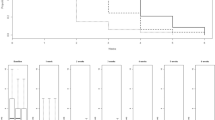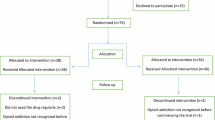Abstract
Purpose
We evaluated the efficacy of oral administration of a mixture of diosmin, coumarin glycosides, and Centella asiatica (Venoplant®) in preventing bleeding, pain, and thrombosis of internal and external hemorrhoids after stapled anopexy (SA).
Methods
SA was conducted in 182 patients with third-degree hemorrhoids. Preoperatively, patients were randomized evenly into two groups. Group A patients were administered Venoplant for 30 days post-SA, and group B received a placebo for 30 days post-SA. Patients received paracetamol for postoperative pain. Visit (v)1, v2, and v3 took place 7, 15, and 30 days postoperatively, respectively; bleeding (clinical examination), visual analog scale (VAS), thrombosis (clinical examination), and pain (paracetamol dosage, VAS) were evaluated.
Results
At v1, v2, and v3, the numbers of patients with bleeding in groups A and B were 21 and 46, 3 and 25, and 1 and 5, respectively (p < 0.05). At v1, v2, and v3, the numbers of patients in groups A and B with thrombosed internal hemorrhoids were 3 and 13, 2 and 11, and 1 and 8, respectively (p < 0.05). The number of patients who took at least one paracetamol tablet was similar in both groups at v1 but was significantly greater in group B than group A at v2 and v3 (p < 0.05); pain VAS scores were equivalent at v1 and significantly greater in group B than group A at v2 and v3 (p < 0.05).
Conclusions
Venoplant effectively reduced bleeding after SA, decreased the incidence of thrombosed internal hemorrhoids, and decreased postoperative pain.





Similar content being viewed by others
References
Longo A. 1998 Treatment of haemorrhoidal disease by reduction of mucosa and haemorrhoidal prolapse with a circular stapling device: a new procedure. Proceedings of the 6th World Congress of Endoscopic Surgery Rome 3–6, pp. 777–784
Porrett LJ, Porrett JK, Ho YH (2015) Documented complications of stapled hemorrhoidopexy: a systematic review. Int Surg 100:44–57
Ortiz H, Marzo J, Armendáriz P, De Miguel M (2005) Stapled hemorrhoidopexy vs. diathermy excision for fourth-degree hemorrhoids: a randomized, clinical trial and review of the literature. Dis Colon Rectum 48:809–815
Sobrado CW, Cotti GC, Coelho FF, Rocha JR (2006) Initial experience with stapled hemorrhoidopexy for treatment of hemorrhoids. Arch Gastroenterol 43:238–242
Perera N, Liolitsa D, Iype S, Croxford A, Yassin M, Lang P, Ukaegbu O, van Issum C (2012) Phlebotonics for haemorrhoids. Cochrane Database Syst Rev 8:CD004322
Altomare DF, Roveran A, Pecorella G, Gaj F, Stortini E (2006) The treatment of hemorrhoids: guidelines of the Italian Society of Colorectal Surgery. Tech Coloproctol 10:181–186
Ho YH, Foo CL, Seow-Choen F, Goh HS (1995) Prospective randomized controlled trial of a micronized flavonodic fraction to reduce bleeding after hemorrhoidectomy. Bri J Surg 82:1034–1035
La Torre F, Nicolai AP (2004) Clinical use of micronized purified flavonoid fraction for treatment of symptoms after hemorrhoidectomy: results of a randomized, controlled, clinical, trial. Dis Colon Rectum 47:704–710
Ebbinghaus SW, Mahler JL, Marshall ME 1997. Novel coumarin activity on albino rats and shows anti-coagulant and anti-oxidant activity. Wiley; 45:195–209
Gohil KJ, Patel JA, Anuradha K, Gajjar AK (2010) Pharmacological review on Centella asiatica: a potential herbal cure-all. Indian J Pharm Sci 72:546–556
Forte R, Cennamo G, Bonavolontà P, Pascotto A, de Crecchio G, Cennamo G (2013) Long-term follow-up of oral administration of flavonoids, Centella asiatica and Melilotus, for diabetic cystoid macular edema without macular thickening. J Ocul Pharmacol Ther 29:733–737
Goligher JC, Lealock AG, Brossy JJ (1955) Surgical anatomy of the anal canal. Br J Surg 43:51
Lohsiriwat V (2012) Hemorrhoids: from basic pathophysiology to clinical management. World J Gastroenterol 18:2009–2017
Aigner F, Gruber H, Conrad F et al (2009) Revised morphology and hemodynamics of the anorectal vascular plexus: impact on the course of hemorrhoidal disease. Int J Color Dis 24:105–113
Cospite M (1994) Double-blind, placebo-controlled evaluation of clinical activity and safety of MPFF in the treatment of acute haemorrhoids. Angiology 445:566–573
Incandela L, Cesarone MR, Cacchio M et al (2001) Total triterpenic fraction of Centella asiatica in chronic venous insufficiency and in high-perfusion microangiopathy. Angiology 52(Suppl 2):S9–13
Lyseng-Williamson KA, Perry CM (2003) Micronised purified flavonoid fraction: a review of its use in chronic venous insufficiency, venous ulcers and haemorrhoids. Drugs 63:71–100
Pleşca-Manea L, Pârvu AE, Pârvu M, Taămaş M, Buia R, Puia M (2002) Effects of Melilotus officinalis on acute inflammation. Phytother Res 16:316–319
Lessiani G, Iodice P, Nicolucci E, Gentili M (2015) Lymphatic edema of the lower limbs after orthopedic surgery: results of a randomized, open-label clinical trial with a new extended-release preparation. J Biol Regul Homeost Agents 29:805–812
Matsuda H, Morikawa T, Ueda H, Yoshikawa M (2001) Medicinal foodstuffs. XXVII. Saponin constituents Gotu Kola (2): structures of new ursane- and oleanane-type triterpene oligoglycosides, centellasaponin B, C, and D, from Centella asiatica cultivated in Sri Lanka. Chem Pharm Bull 49:1368–1371
Inamdar PK, Yeole RD, Ghogare AB, de Souza NJ (1996) Determination of biologically active constituents in Centella asiatica. J Chromatogr A 742:127–130
Bonfill M, Mangas S, Cusidó RM, Osuna L, Piñol MT, Palazón J (2006) Identification of triterpenoid compounds of Centella asiatica by thin-layer chromatography and mass spectrometry. Biom Chromatogr 20:151–153
Yao CH, Yeh JY, Chen YS, Li MH, Huang CH (2015) Wound-healing effect of electrospun gelatin nanofibres containing Centella asiatica extract in a rat model. J Tissue Eng Regen Med. doi:10.1002/term.1992
Cesarone MR, Laurora G, De Sanctis MT, Belcaro G (1992) Activity of Centella asiatica in venous insufficiency. Minerva Cardioangiol 40:137–143
Tenni R, Zanaboni G, De Agostini MP (1988) Effect of the triterpenoid fraction of Centella asiatica on macromolecules of the connective matrix in human skin fibroblast cultures. Ital J Biochem 37:69–77
Arpaia MR, Ferrone R, Amitrano M (1990) Effects of Centella asiatica extract on mucopolysaccharide metabolism in subjects with varicose veins. Int J Clin Pharmacol Res 10(4):229–233
Mlakar B, Kosorok P (2005) Flavonoids to reduce bleeding and pain after stapled hemorrhoidopexy: a randomized controlled trial. Wien Klin Wochenschr 117:558–560
Casley-Smith JR, Foldi-Borksok E, Foldi M (1974) Fine structural aspects of lymphoedema in various tissues and the effects of treatment with coumarin and troxerutin. Br J Exp Pathol 55:88–93
Casley-Smith JR, Földi-Börcsök E, Földi M (1975) A fine structural demonstration that some benzopyrones act as vitamin P in the rat. Am J Clin Nutr 28:1242–1254
Bubols GB, Vianna Dda R, Medina-Remon A et al (2013) The antioxidant activity of coumarins and flavonoids. Mini Rev Med Chem 13:318–334
Gravié JF, Lehur PA, Huten N et al (2005) Stapled hemorrhoidopexy versus Milligan–Morgan hemorrhoidectomy: a prospective, randomized, multicenter trial with 2-year postoperative follow up. Ann Surg 242:29–35
Acknowledgments
We thank Mr. Simone Teso, MD (University of Padua, Italy), for performing the statistical analyses.
Author information
Authors and Affiliations
Corresponding author
Ethics declarations
Conflict of interest
Aesculapius Pharmaceuticals (Brescia, Italy) provided Venoplant, the placebo, and paracetamol tablets. The authors enrolled patients independently and did not provide access to data or results to staff from Aesculapius Pharmaceuticals. Statistical analyses were undertaken in a blinded fashion by an independent statistician who communicated the results to the authors only at the end of the study.
Ethical approval
All procedures performed in studies involving human participants were in accordance with the ethical standards of the institutional and/or national research committee and with the 1964 Helsinki Declaration and its later amendments or comparable ethical standards.
Informed consent
Informed consent was obtained from all individual participants included in the study.
Electronic supplementary material
ESM 1
(XLS 90 kb).
Rights and permissions
About this article
Cite this article
Schiano di Visconte, M., Nicolì, F., Del Giudice, R. et al. Effect of a mixture of diosmin, coumarin glycosides, and triterpenes on bleeding, thrombosis, and pain after stapled anopexy: a prospective, randomized, placebo-controlled clinical trial. Int J Colorectal Dis 32, 425–431 (2017). https://doi.org/10.1007/s00384-016-2698-z
Accepted:
Published:
Issue Date:
DOI: https://doi.org/10.1007/s00384-016-2698-z




